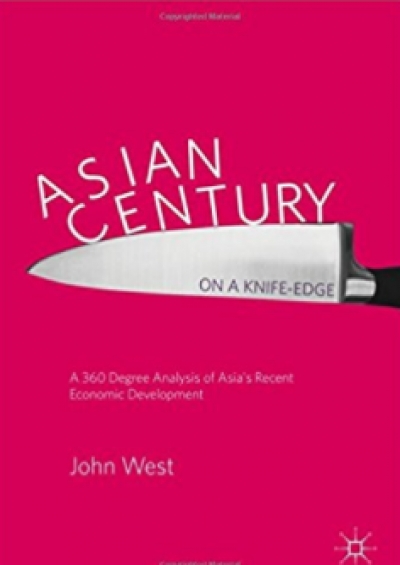Seven Challenges for an Asian Century
To reach its full potential, Asia will need to overcome seven key challenges in the 21st century.
February 5, 2018

1. Getting better value out of global value chains
Asia appears a global leader in international trade and investment. But the reality is that countries like China, India and Indonesia are mainly undertaking lower value added activities in global value chains like assembling electronics and automobiles, “cut sew and trim” of clothing and operating call centers.
Much greater efforts are required to get better value out of value chains by opening markets, strengthening human capital and technological and innovative capacities.
2. Making the most of urbanization’s potential
Many of Asia’s factories and call centers are staffed by poor migrants who have moved to towns and cities in the hope of a better life. But their dreams are all too often shattered as they wind up living in urban slums.
In the case of China, most internal migrants are denied access to basic social services and their children are “left-behind” in traditional villages. And Asia’s most advanced cities like Singapore, Hong Kong, Tokyo and Seoul lag sadly behind the West in the quest to become hubs of innovation and creativity.
3. Giving all Asians a chance!
Discrimination, prejudice and persecution are rife in Asia, thereby preventing economies and societies to realize their full potential, as our review shows for the cases of: Asia’s LGBT community; Japanese women; South Asian women who suffer gendercide, forced child marriages and honour killing; Asia’s indigenous peoples like West Papuans, Tibetans and China’s Uighurs; Sri Lanka’s Tamil community; and India’s lower castes.
4. Solving Asia’s demographic dilemmas
Most Asian countries face intractable demographic dilemmas. In much of East Asia, fertility has plummeted below replacement rates, populations are ageing, workforces declining and in Japan the population has begun falling.
And yet governments are slow to react. At the same time, in South Asia, Indonesia and the Philippines, a youth bulge is bursting into the workforce, but much of this youth is not well educated and there are not enough jobs on offer.
A potential demographic dividend could easily morph into an explosion of social frustration. Connecting these two demographic realities is the potential for mutually beneficial migration, and yet ethnocentric Asia is barely open to migration.
5. Fixing Asia’s flawed politics
Asia is crying out for democracy and better governance to improve the foundations for stronger economies and decent middle class societies. And yet, according to some measures, there would not be even one mature democracy in Asia.
Contrary to the hopes of political scientists, economic development has fostered too few democracies in Asia.
Asia’s political landscape is deeply flawed with: Oligarchic democracies in Japan and Korea; pro-business soft dictatorships in Hong Kong, Malaysia and Singapore; Chinese client states in Cambodia and Laos; weak and fragile democracies in India, Indonesia, Philippines, Mongolia, Sri Lanka, Bangladesh, and Nepal; military-dominated governments in Thailand, Pakistan, and Myanmar; and staunchly authoritarian states in China, North Korea and Vietnam.
6. Combating Asia’s economic crime
One of the many consequences of these flawed politics is that, as Asia has moved towards the centre of the global economy, it has also moved to centre of the global criminal economy.
Asia is a major player in many aspects of economic crime like counterfeiting and piracy, Illegal drug production and trafficking, environmental crimes, human trafficking and smuggling, corruption and money laundering, and cybercrime.
And while flawed politics is one of the causes, this criminality is eating away at the integrity of the state, as state actors are very often criminals themselves or are colluding with criminals.
7. Can Asian countries live together in peace and harmony?
While many factors have underpinned Asia’s renaissance over the past half century or more, the relative peace that the region has enjoyed has been perhaps the most important.
But today, the relative stability of postwar Asia, led by the United States, is being shaken by the rise of China, as China is now engaged in a bitter power struggle with the United States and its Asian allies for the political leadership of Asia.
There is much debate about whether this will lead to military conflict between China and the United States. In any event, the United States seems to be losing its hold over Asia, something which will likely accelerate under the Trump administration.
This means that it will become ever more necessary for Asian countries to cooperate better together. But this will be a great challenge in light of the tensions involving China, North Korea, Japan, Taiwan, Hong Kong, South Korea and India.
Editor’s note: This feature is adapted from Asian Century… on a Knife-edge: A 360 Degree Analysis of Asia’s Recent Economic Development (Palgrave Macmillan, 2018).
Takeaways
To reach its full potential, Asia will need to overcome key challenges in the twenty-first century.
Discrimination, prejudice and persecution are rife in Asia, thereby preventing economies and societies to realize their full potential
Most Asian countries face intractable demographic dilemmas. In much of East Asia, fertility has plummeted below replacement rates and populations are ageing.
Asia is crying out for democracy and better governance to improve the foundations for stronger economies and decent middle class societies.
The relative stability of postwar Asia, led by the US, is being shaken by the rise of China.
